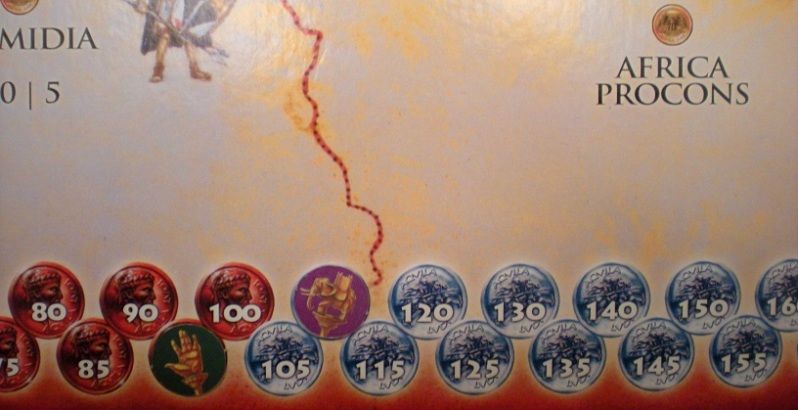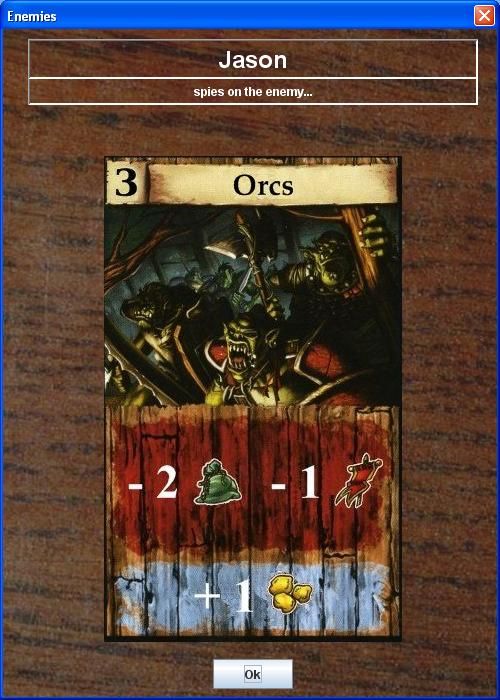"My master made me this collar so I could talk, he is very smart----SQUIRREL!"
My kids are very active. To put such a simple statement in perspective, that's like saying the sun is pretty hot. Now don't get me wrong, this is generally a good thing. They stay busy, can entertain themselves, and are highly imaginative; on one occasion turning our house into a model of the Red November for a LARP-like adventure game, replete with numbered rooms and Libby, the house cat, standing in as the Kraken. Thankfully the house did not catch on fire. Yet this quality often stands in stark contrast with another characteristic required of many board games: waiting. Simply stated, I'm not really sure that my kids are designed to sit still. I once thought that this inability was the direct result of today's barrage of ceaseless entertainment options, namely of the electronic type. I now doubt that assessment. Video consoles, computers, iPods, and 19 different Disney channels are not the root cause of this youthful phenomenon, though they certainly compound it. But to understand the real reason would require a geneticist, psychologist, and soccer mom all in the same room, which only sounds like the opening to a lame joke.
The basic conundrum here is: my kids really want to play board games, but often get bored when it's not their turn. Sometimes I wonder if my kids have the ability to focus any longer than Doug the dog, on the movie Up, unless their brains are constantly occupied by some busy stimuli - either external or internal. Even so, they possess an uncanny knack of abruptly switching focus from one activity or mental thought to another, despite having had 100% concentration in the former but a moment previously and regardless whether that former task is complete or not. Most adults tend to prefer things "tied up" and completed before moving on to the next. Some, like me, can even be compulsive and anal about such things. Honestly, I can't remember when I haven't been like that, though my mother assures me to the contrary.
Beyond those designed specifically for children, many board games require a fair amount of focus and patience that can pose a challenge for them. There are some well-known remedies in the hobby to address, or work around, this issue. You can play quick, light-weight affairs, even more "filler" type games, designed with simple rules and almost no chrome (we have Mag Blast to fit this bill). There are many games designed to play in an hour or under (Mission: Red Planet is a nice example in our small collection). These types are especially handy in developing patience while battling short attention spans. And still many games that run longer than 60 minutes have short or even simultaneous turn structures which alleviate downtime (we really like how Kingsburg keeps everyone involved nearly the entire game).
You could also resort to a two-player game, if feasible. If you have more than one child, the desire to include all of your kids so that no one feels left out is certainly worthy and important. However, it may be advantageous to dividing some game play. Consider experimenting with the practice of devoting some game time to one child and some equal time to the other. Even if they're only a couple of years apart and relatively at the same level, there are benefits to one-on-one play in developing game etiquette, not the least of which is focus and patience. That's not to deny family game sessions when they all really want to play. There is definitely a place and need for both. And one dynamic of having multiple kids is that you'll be dealing with as many different interests. So when one child balks at a title brought to the table for one session, it's a good opportunity to respond, "Well how about I play this with her, and then you and I can play your favorite game next."
However, when engaged in any five-player game with four kids, you're not going to avoid downtime completely. And while they sit there, waiting for their next turn, with no active, external input to stir their brain activity, they slowly lose focus on the task at hand. Their imaginations take over and soon they're off in their own world fiddling, fidgeting, talking, singing, and sometimes dancing and climbing on the furniture. The distraction can be an obstacle to say the least. To some extent, I have simply learned to live with it as a natural by-product of gaming with kids. On the other hand, it's only practical to limit such distractions and even constructive for the kids in developing patience. And so, in addition to employing all other tried and true measures, I have begrudgingly resorted to one other means that I promised never to allow at the game table: personal electronic devices.
There are still rules. The volume stays down - otherwise they become a distraction themselves. The devices are to be set aside when one's turn does roll around. Gameboys and iPods are convenient in that they are compact and have a handy pause button which can be pressed at almost anytime. When first introducing my kids to the hobby, I was adamant about shelving such toys while gaming. Indeed, part of the whole purpose of board gaming was to provide an alternative avenue to video games. Not lost to the irony, now they give my kids something to do while they sit and wait for their next turn in those games that progress a bit slower for their tastes. Instead of creating a distraction as I first feared, they are actually proving useful, albeit with moderation and limits. They can occupy the kids during the "waiting game" as they learn to develop a greater sense of gaming focus. With time and experience (okay, indoctrination doesn't hurt, either), they will grow into it.
However, allowing such deveices may not be the best solution in all cases. What about you and your family's gaming sessions? And not to single out children; how does your peer group deal with distractions and lack of focus? Are iPads and cell phones taboo----SQUIRREL!

















